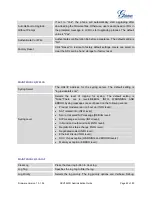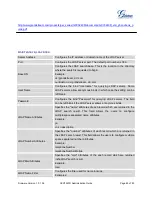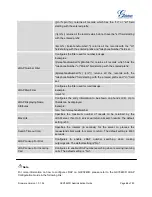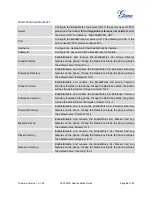
Firmware Version 1.0.1.54
GXV3240D Administration Guide
Page 75 of 83
http://www.grandstream.com/support/firmware
Alternatively, users can download a free TFTP or HTTP server and conduct a local firmware upgrade. A
free windows version TFTP server is available for download from:
http://www.solarwinds.com/products/freetools/free_tftp_server.aspx
Instructions for local firmware upgrade via TFTP:
1. Unzip the firmware files and put all of them in the root directory of the TFTP server;
2. Connect the PC running the TFTP server and the GXV3240D device to the same LAN segment;
3. Launch the TFTP server and go to the File menu->Configure->Security to change the TFTP server's
default setting from "Receive Only" to "Transmit Only" for the firmware upgrade;
4.
Start the TFTP server and configure the TFTP server in the phone’s web configuration interface;
5. Configure the Firmware Server Path to the IP address of the PC;
6. Update the changes and reboot the GXV3240D.
End users can also choose to download a free HTTPserver from
IIS web server.
PROVISIONING AND CONFIGURATION FILE DOWNLOAD
Grandstream SIP Devices can be configured via the Web Interface as well as via a Configuration File
(binary or XML) through TFTP or HTTP/HTTPS. The "Config Server Path" is the TFTP, HTTP or HTTPS
server path for the configuration file. It needs to be set to a valid URL, either in FQDN or IP address format.
The "Config Server Path" can be the same or different from the "Firmware Server Path".
A configuration parameter is associated with each particular field in the web configuration page. A
parameter consists of a Capital letter P and 2 to 3 (Could be extended to 4 in the future) digit numeric
numbers. i.e
., P2 is associated with the “Admin Password” in the Web GUI->
Maintenance
->
Web/SSH
Access
page. For a detailed parameter list, please refer to the corresponding firmware release
configuration template in the following link:
http://www.grandstream.com/support/tools
When the GXV3240D boots up, it will issue TFTP or HTTP request to download a configuration XML file
named"cfgxxxxxxxxxxxx" followed by "cfgxxxxxxxxxxxx.xml", where"xxxxxxxxxxxx"is the MAC address of
the phone, i.e., "cfg000b820102ab" and "cfg000b820102ab.xml". If downloading "cfgxxxxxxxxxxxx.xml"
file is not successful, the provision program will download a generic cfg.xml file. The configuration file
name should be in lower case letters.
























